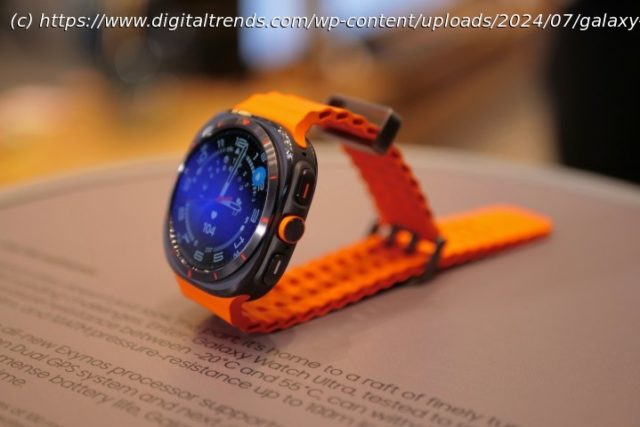The Galaxy Watch Ultra is an impressive new adventure smartwatch from Samsung, but how does it compare to the class-leading Apple Watch Ultra 2?
This year, Samsung has taken its wearables to an impressive new level with the new Galaxy Watch Ultra, a smartwatch that’s inevitably drawing comparisons with its biggest rival, the Apple Watch Ultra 2.
From the name to the design, it’s apparent that this is precisely what Samsung was going for. However, it’s unfair to call the Galaxy Watch Ultra merely a copycat product. There are also some ways in which Samsung has put its unique spin on the new extreme wearable, and it’s certainly a much better fit for the needs of outdoor adventure enthusiasts than 2022’s Galaxy Watch 5 Pro, which was a decent smartwatch that suffered from a bit of an identity crisis.
On the other hand, the Galaxy Watch Ultra has an opinionated design that leaves no room for confusion about what it is and who it’s for. In that sense, it’s every bit as bold and brave as the Apple Watch Ultra 2, but can it hold its own given Apple’s two-year head start? Let’s find out.Samsung Galaxy Watch Ultra vs. Apple Watch Ultra 2: specsSamsung Galaxy Watch Ultra vs. Apple Watch Ultra 2: design
At first glance, the Galaxy Watch Ultra seems like a big departure from Samsung’s typical round design. Its square body immediately brings Apple’s iconic smartwatch designs to mind, but Samsung has actually taken a hybrid approach here.
The Galaxy Watch Ultra may have a square body, but that’s where the similarities to the Apple Watch Ultra both begin and end. Samsung hasn’t embraced a square display to go along with the new design. Instead, it’s a traditional round watch face, and those who look beyond the realm of smartwatches will recognize its inspiration from other sources like Bell & Ross and Tag Heuer — not to mention its eerie similarity to the Hermès H08. It’s perhaps ironic that Hermès is a longtime partner of Apple on luxury Apple Watch editions, but it also has nothing to offer in the Apple Watch Ultra space.
The Galaxy Watch Ultra comes in slightly smaller than the Apple Watch Ultra 2, with a 47mm casing versus Apple’s bulkier 49mm casing, but that’s also a byproduct of a somewhat more stylish design. The Apple Watch Ultra 2 is a wearable that makes a big and bold statement, but fashionable it’s not. The Galaxy Watch Ultra may have a slightly more polarizing design, but its similarity to other luxury brands is unmistakable, giving it a certain panache that Apple’s wearable lacks.
Nevertheless, when it comes to raw design specs, the Apple Watch Ultra 2 does have one significant edge over the Samsung Galaxy Watch Ultra. While both wearables are rated for 10 atmospheres (10ATM) of water pressure, which equals a depth of 100 meters, only the Apple Watch Ultra is certified for diving, with an EN13319 rating for use as a dive computer and for recreational scuba diving at depths of up to 40 meters.
That’s significant because despite being able to handle up to 100 meters of water pressure, Samsung says in the fine print that the Galaxy Watch Ultra is only suitable for “shallow-water activities like swimming in a pool or ocean.” That’s consistent with its 10ATM rating, which is designed only for swimming, snorkeling, or high-speed water sports like surfing and water skiing. That 10ATM designation means 100 meters of still water, and all bets are off when you exert extra pressure on it.
While it’s less relevant in light of the 10ATM rating, the Galaxy Watch Ultra also features an IP68 rating that matches Samsung’s higher-end smartphones. It’s fully dust-resistant and can withstand immersion in up to 1.5 meters of water for up to 30 minutes. Instead of an IP water-resistance rating, Apple hangs its hat on its 10ATM and EN13319 ratings, giving the Apple Watch Ultra only an IP6X for the same level of protection against dust and other small particles. However, unlike IP68/IPX8, the 10ATM rating covers salt water, so ocean swimming won’t be a problem. Both wearables are also tested to MIL-STD-810H for altitude, extreme temperatures, humidity, immersion, freezing and thawing, salt and fog, and shock and vibration.
The band attachment system is also worth mentioning here, as Samsung has done something slightly unusual with the Galaxy Watch Ultra. Rather than slanting downward toward the wrist, the bands connect at an angle parallel to the case, which makes the Watch sit a bit more awkwardly on the wrist. More significantly, the bands attach with a new dynamic lug system that’s unique to the Galaxy Watch Ultra. This will limit you to bands made specifically for the Galaxy Watch Ultra, leaving it out of the vibrant ecosystem of bands for every other Galaxy Watch model.
By comparison, the Apple Watch Ultra is compatible with every 42/44/45mm Apple Watch band released since the original 2015 Apple Watch. Some smaller bands may look a bit strange against the bulkier Apple Watch Ultra, but they’ll attach just fine.Samsung Galaxy Watch Ultra vs. Apple Watch Ultra 2: display
Samsung’s and Apple’s Ultra wearables are more evenly matched in display quality. The Apple Watch Ultra features a slightly larger screen, with a diagonal length of 1.94 inches, compared to the Galaxy Watch Ultra’s 1.5-inch screen, but the latter makes up for that with a higher resolution, putting both roughly on par in terms of pixel density — 335 pixels per inch (ppi) for the Apple Watch Ultra 2 versus 320 ppi for the Galaxy Watch Ultra.
That’s not a difference anyone will notice with the naked eye. Tthe Apple Watch has a rectangular 410 x 502 display with 205,820 pixels, while the Galaxy Watch Ultra’s round 480 x 480 display only has 180,956 pixels as it has no corners to fill.
Both displays are plenty bright, reaching up to 3,000 nits of peak outdoor brightness. That should get you through even the sunniest outdoor adventures without any difficulty. Samsung has also embraced Apple’s red Night Mode, which is easier on the eyes in the dark and won’t affect your night vision on a camping trip or evening hike.Samsung Galaxy Watch Ultra vs. Apple Watch Ultra 2: performance
Samsung has given its wearables a nice performance boost this year by adopting a new five-core Exynos W1000 chip that promises to be about 3x faster and 30% more power-efficient than last year’s Exynos W930.






